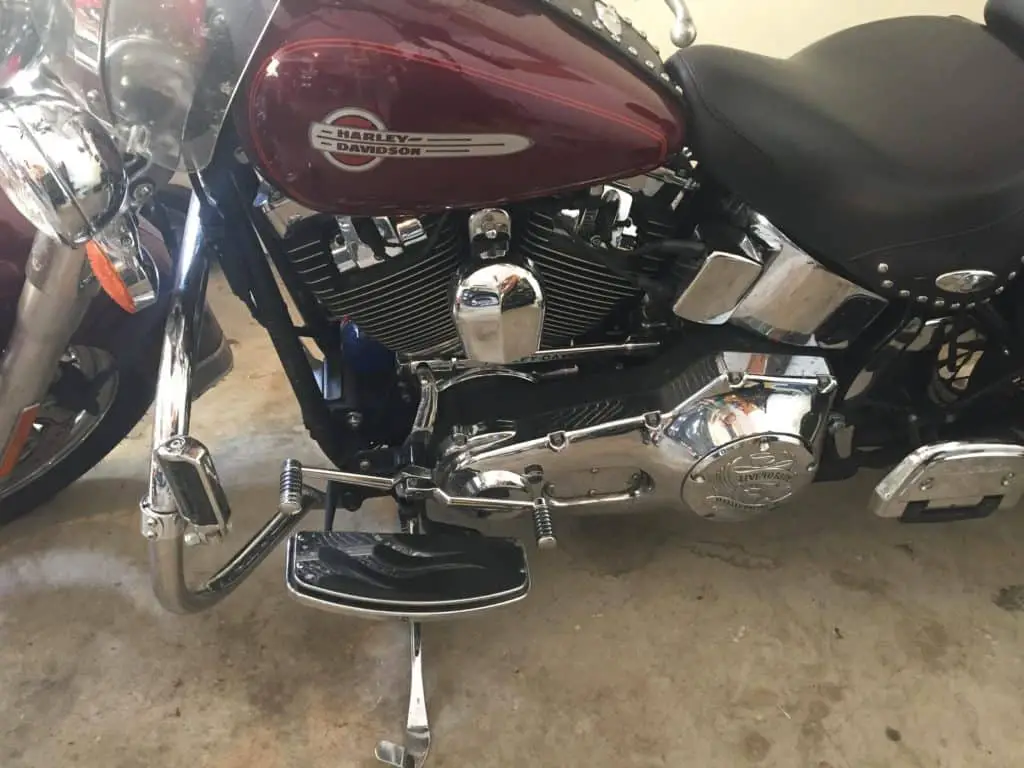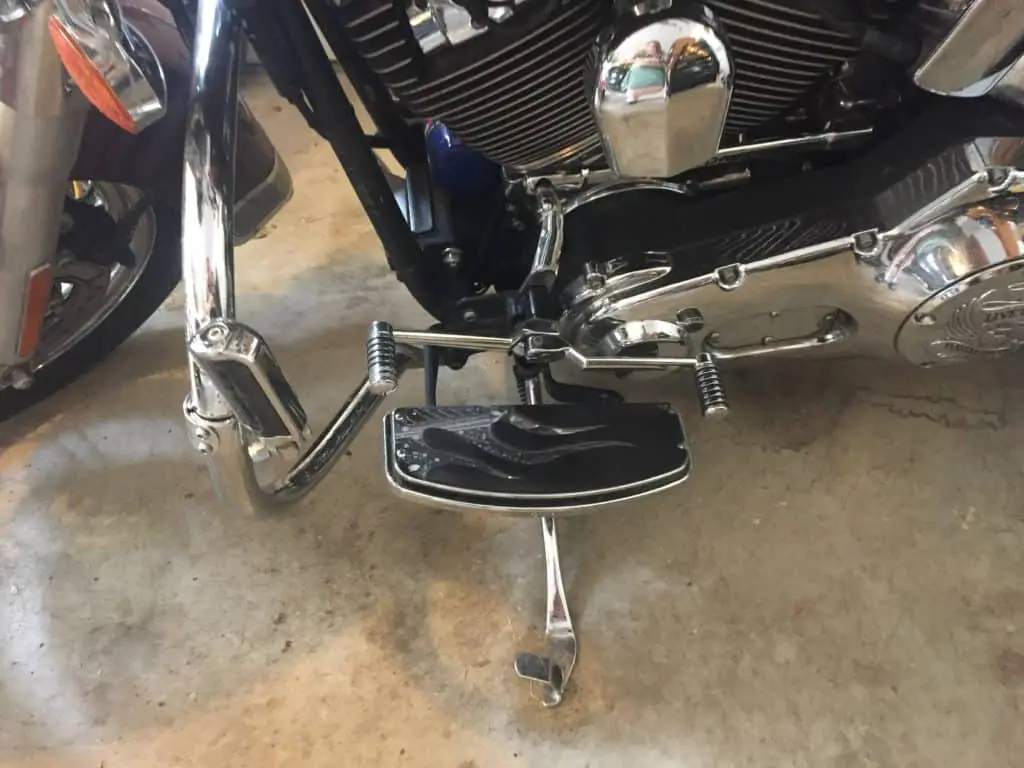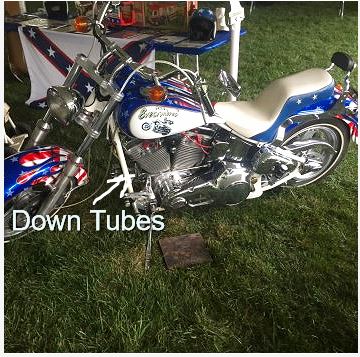
I was pulling my Harley out from storage the other day and hit my shin on the highway peg. It really hurt. The first thoughts out of my head were a string of four-letter words. I then told myself the highway pegs were in the wrong spot. But were they really?
What is the best position for highway pegs on a cruiser motorcycle? The best position for highways pegs allow you to have the highest level of comfort with bent knees. Height, motorcycle, style of highway peg, and use all influence the best position. You want to avoid positions that straighten your legs.
On the surface, this seems simple but here are other things you need to consider for positioning your highway pegs.
Use of Highway Pegs And Location For Your Cruiser
If you are new to cruisers and looking for a set of highway pegs, you will find three uses for them.
The most common will use will be additional foot locations for increased comfort. As the answer stated above, many factors influence where you place the pegs.
The bling factor will be the second use of the highway peg. They are additional chrome pieces a rider can add to their bike. I cannot tell you how many people ride and do not use them. A couple of years ago I came across a guy who installed them and had not put them in the use position (they were the folding kind) after 5 years. He liked they way they looked on the bike.
Placement for the bling factor shows the most chrome or “looks the coolest.”
The last and not commonly thought of use involves flipping them upside down, if you have the folding kind. When extended while upside down it acts an extender of your highway crash bar.
There is one large benefit to flipping them upside down if you drop the bike. It will not fall over as far making it much easier to pick up the bike. Your best placement for this purpose is to have them extend as far away from the bike as you can making them perpendicular to the down tube.
Leg Position For Your Cruiser Highway Pegs
We will discuss factors influencing highway peg positioning. Here is each factor with a point or two for consideration to place your highway pegs.
| Factor | What you need to know |
| Bent Knee | Helps keep your knees from hurting. Degree of bend depends on the Rider |
| Height | Your pegs should be further forward the taller you are. It may make mount them difficult. |
| Motorcycle | Since bikes are different, you need to make sure the pegs you buy fit and will be comfortable. |
Bent Knee– Have you ever sat in a chair with your legs extended straight for a long period? Yep, me too. Your legs, specifically the backs of your knees hurt. Having your legs slightly bent will improve the comfort of your ride.
The amount of bend depends on preference. I ride with some people who almost keep their legs straight and others who can not have them straight for any length of time.
Height- The taller you are the further away your highway pegs will be. Makes sense when you consider most tall people have longer legs. Keep this in mind if you have taller passengers.
Unless, your tall and have short legs, consider buying extenders to place the highway pegs in front of the crash bar or down tubes depending on where you mount the peg. Here is a reasonably priced set-up from JP Cycles that look good on any motorcycle, and will last as long as you own the bike.
Motorcycle- Thankfully motorcycles are not the same. It should not surprise you to know different bikes will require different highway pegs. The result will place your feet in different areas and influence leg position.
Different Kinds of Motorcycle Highway Pegs
Let’s talk about the different kinds of highway pegs. As you continue reading, think about your goal for buying the pegs. Comfort, style, or crash bar extension? Your goal influences the style of peg you should purchase.

| Type of Peg | Consideration |
| Highway Bar Mounted Pegs | Very versatile but pose a shin hazard while bike is parted. |
| Floorboard Mounted Pegs | Budget Friendly but reduce bikes lean angle. |
| Frame Mounted Pegs | Good alternative to Highway Pegs, but cannot have a radiator. |
Highway Bar Mounted Pegs
Everyone has seen a highway bar on a motorcycle. It is the circular bar extending away from the motorcycle at the front the motor.
Every police motorcycle I have ever seen has one. If you that mental picture does not help, here is a picture of my motorcycle. Highway bar pegs mount on this circular tube.
As you can see from the picture, I have highway bar mounted pegs. I chose these because:
- I can flip them so they are within the bar or outside of the bar.
- I already had the crash bar on the bike.
- The pegs can flip up or down.
- When you flip the pegs upside down, it keeps the bike from falling over to far. I use this feature when practicing my drills. I have a higher chance of dropping the bike.
There are a few cons of using these pegs:
- If you use them while going down the road and they are up, you must take your hands off the handlebars. I have used my foot to “kick” them down, but this is dangerous. It makes the bike wobble of you jerk your foot to hard.
- When left out, they pose a shin hazard. I cannot tell you the number of times I hit my legs on those things because I did not put them in the up position after a ride and parked the bike.
- For some riders the nature of these pegs spread your legs far apart making them uncomfortable.
Floorboard Mounted Highway Pegs
When riders need to shop on a budget, they may turn to floorboard mounted highway pegs.
Most of the time, the pegs get bolted onto the outer edge of the floorboard. The pegs like the highway bar mounted pegs fold up and down.
Because of their positioning, it will reduce the lean angle of the bike. The lower lean angle results in the motorcycle dragging earlier in a turn than it would by using the other style of highway pegs.
Similar to the crash bar mounted pegs, your legs get spread wide. If this makes you uncomfortable, avoid this style of peg.
Not all floorboard highway pegs mount on the outside of the floorboard. Some styles mount on the bottom of the floorboard placing the highway peg near the brake and shifter.
Be careful of the tradeoff in using pegs in this position. Riders who favor this placement think it gives them increased safety and improved performance. You may be wondering how?
They tell me your foot travels less distance to reach the brake and you can shift faster (think downshifting to pass a car on the highway.) While I cannot speak from experience, it seems this proximity could also make you accidentally step on the brake or shifter when repositioning your feet. The result could be an accident.
Just make sure you consider the trade-offs for any style of highway peg you choose.
Frame Mount Highway Pegs
If you do not have a radiator on your bike, frame mounted pegs should be an option for you.
These pegs get mounted on the down tubes in the front of your motor.

I like the fact you can adjust the height of these pegs so it locates them right above your floorboards (if you have them) or forward pegs.
These would be a good alternative to the highway bar mounted pegs. Even with the crash bar still on the bike, you can have the frame-mounted pegs.
Here is one of the most popular sets of frame mounted pegs at JP Cycle. They are much better than the set I had on my 70’s KZ bike.
Parts of the Highway Peg
Clamp– The clamp bolts directly to the motorcycle or crash bar. You will need to measure the diameter of your attachment point to buy the proper clamp.
You should note, not all points of attachment will require a clamp, the floorboard mounting areas usually bolt on to the bike.
Arm– The arm attaches to the clamp for peg positioning. It will use threes styles to attach to the clamp.
- Long arm- As the name shows, placing the peg will be further away from the attachment point to the motorcycle or clamp.
- Off Set- The off-set arm has a large bend moving the peg placement next to the point of attachment. Check out of one my favorite off-sets at JP Cycle.
- Clevis- While not really an arm, it is the point where a peg attaches directly to the clamp.
Peg– Pegs are the points where feet get placed and covered with some form of rubber.
Can Passengers Have Highway Pegs?
Yes, passengers can have highway style pegs. Kuryakyn (sold by JP Cycles) make adjustable passenger pegs. Although they differ from what we discussed for the rider.
First, there are not as many choices for the passenger because of the lack of room to place the second set of pegs. Since many of the passenger pegs are adjustable, the passenger will create additional comfort versus being cooped up with traditional style passenger pegs.
If you ride two up frequently on long trips, it will be worth the investment for the passenger who gets overlooked most of the time on creature comforts.
Passenger Height Affect the Highway Pegs Position
You need to know of your passenger’s height. My wife is 5’10″ and can only ride a short distance. Part of the problem is her lack of time in the saddle but I have also not installed passenger highway pegs.
My bike has the extenders on the passenger floorboards which help.
When I looked at adding the passenger pegs, we could not find any that would create additional comfort for her preferred foot position. When buying highway style pegs for your passenger, I suggest going into a few dealerships and sit with your passenger on used bikes since they have different styles of pegs when traded in.
This will be a good starting point since the passenger can try the pegs and you can see what level (if any) of change they may have.
Related Questions:
What are highway pegs? Highway pegs are auxiliary pegs put on your motorcycle (most commonly on a cruiser and adventure bikes) so the rider has additional places to put their feet. Used mainly for highway riding. The pegs fold up and down depending on their use.
Why use highway pegs? You add the pegs for additional places to put your feet for comfort on long trips. Keeping your feet in the same position for a long duration becomes uncomfortable and does not allow blood to flow well in your legs. By having highway pegs the rider has increased comfort and can ride longer.
